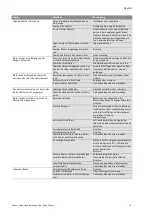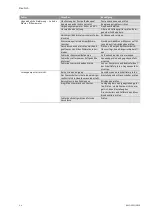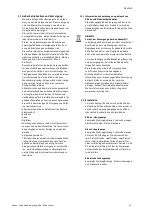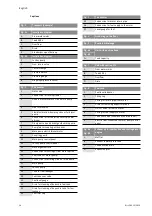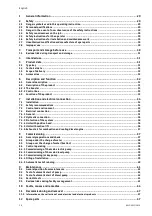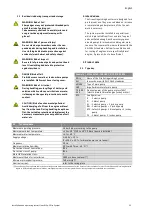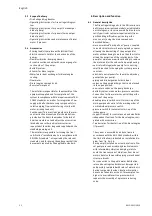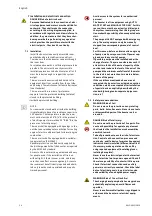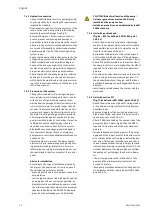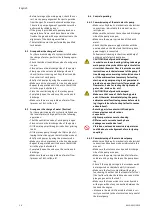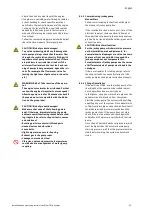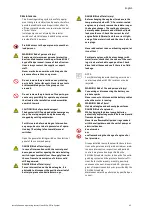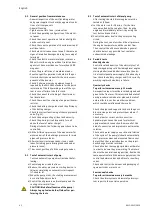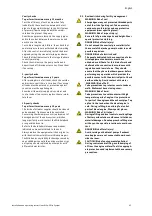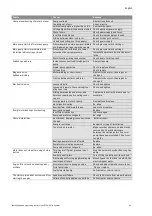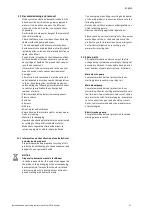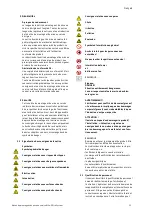
English
Installation and operating instructions Wilo-SiFire System
37
7.4.6 Exhaust air for combustion and cooling diesel
engine
(Fig. 8) (Fig. 9a – 9b & variant)
If the system is assembled with a pump driven by
a diesel engine, the combustion gases of the
engine must be evacuated outside by a pipe sup-
plied with an adequate silencer.
Back pressure cannot exceed recommendations
for the type of diesel engine installed. The exhaust
pipe must have an adequate size relative to the
length of piping. It must be isolated and supplied
with sufficient protections against accidental
contacts with surfaces at high temperatures.
Exhaust tailpipe cannot be close to windows or
doors. Besides, exhaust gas must not come again
in the pump room.
Exhaust tailpipe must be protected from weather
and must not allow the introduction of rainwater
into the exhaust pipe or return of condensates
back to the engine.
Hoses have to be as short as possible (ideally no
longer than 5.0 m), with the fewest possible
curves and a radius less than 2, 5 times the pipe
diameter.
Pipes must be supported, and a condensate drain
system must be supplied with a material resistant
to the acidity of the condensate.
The ventilation system in a pump room with diesel
pumps with air cooling or air/water exchanger is
crucial. This determines the correct functioning of
the fire system.
The ventilation system must allow dissipation of
heat produced during operation of the diesel
pump system and ensure a correct air flow to cool
the engine.
The room’s openings must consider the air flow
necessary for the engine, which may vary accord-
ing to altitude. (See manufacturers’ data of diesel
engine).
8 Commissioning
For the first commissioning, we advise you to hire
the closest Wilo after-sales service agent or to
contact our after-sales call centre.
Commissioning of the booster must be performed
by qualified people.
8.1 General preparations and check
• Before switching on for the first time, check that
the wiring has been done correctly, particularly
the earth connection.
• To make sure that rigid connections are not asso-
ciated to mechanical stress.
• Fill the installation and during visual inspection,
search the possible faults.
• Open gate valves on pump sides and on the dis-
charge pipe.
CAUTION! Risk of product damages!
Never make the system running dry. The dry
running destroys the pump mechanical seal
tightness.
• The jockey pump tank is empty of water; inflate
it to a 0.5 bar lower pressure than the pressure
allowing the start of the jockey pump.
• Don’t exceed the maximum inflation value for
the vessel.
CAUTION! Risk of product damages!
Tighten all the supply terminals before the com-
missioning of the booster!
If during installation it is necessary to conduct
tests, make sure the pumps are properly filled with
water before switching them on.
Before filling the pump unit with water, check the
tightness of components, which could be loos-
ened during transport and handling.
Do not let the booster in automatic mode before
the fire extinguishing system is completed
assembled according to the standard; the com-
missioning of an incomplete fire extinguishing
system rules out the warranty.
Procedure for commissioning
• During the pumping system automatic mode set-
ting, maintenance program procedures and
responsibility of operation in case of accidental
starting must be defined.
• For models with diesel engine, before operating,
check the correct filling of batteries.
• For inspection of batteries, follow instructions
given by manufacturer.
• Keep batteries away from flames and sparkles. For
safety reasons do not lean above the batteries in
operating and during installation or removal.
• Check the correct level of fuel in tanks of diesel
engines and possibly add some fuel when engines
are cold.
• Be careful to not spill fuel on motors, on rubber or
plastic materials of the system.
• DO NOT add fuel when the engines are warm.
Summary of Contents for SiFire EN 100/200-205-45 E
Page 2: ...Fig 1 Fig 2a A 2 2 E B C D ...
Page 3: ...Fig 2b Fig 3 21 25 26 13 11 12 19 15 22 27 20 24 23 2 1 14 4 16 7 5 6 10 18 17 9 9 10 8 3 ...
Page 4: ...Fig 4 Fig 5 ...
Page 5: ...Fig 6a 3 5 D D 4 D 2 3 C min max 1 8 m s Fig 6b min 3 5 D D 4 D max 2 m 2 3 C max 1 8 m s ...
Page 6: ...Fig 7 Fig 8 max 3 2 m min A B C D 2 4 5 6 3 8 7 1 ...
Page 7: ...Fig 9a Fig 9b A B C D 800 800 800 ...
Page 8: ...Fig 1a Fig 9a variant Fig 9b variant A B C D 800 800 800 ...
Page 9: ...Fig 10 Fig 11 1 2 1 2 1 ...
Page 10: ......

